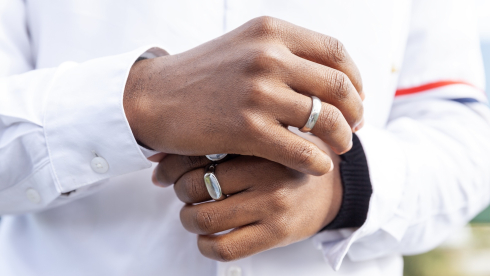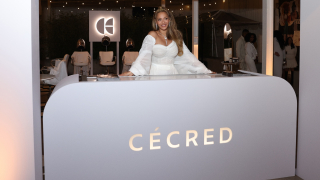Navin Norling’s fascination with sustainable art started on his grandfather's farm. “He was a hardcore recycler at a time when recycling wasn't that very known,” Norling tells EBONY. “He would never throw things away. That was a big impression on my life.”
Norling mixes his rural and urban sensibilities with found materials to create art that examines classic Americana imagery, confronting and commenting on consumerism and popular culture. His 20-plus years in fashion ( "I worked at Dior and St. Laurent"), and discovery of the fetishizing of Black Americana has influenced his creations throughout the years. “I try to make work that first seduces you and then you're in my world and you're stuck,” shares the artist.
Currently showing at the Johnson Lowe Gallery in Atlanta, his work is on a new path. “I want to touch a nerve, but also want to make sure you see some positive light.” Here Norling discusses what he learned from his grandfather and how his own work has evolved throughout the years.
EBONY: When did you discover your love for sustainability?
Navin Norling: I'm a first-generation city person. My mom is from rural south Louisiana, and my grandfather is from Oklahoma. My dad is from Bakersfield, California, and my grandfather was there for about 60 years of his life, but he had a farm where he would always try to fix and mend and rebuild. I spent a lot of time there and started to see the impact of what he did. He had this love of rust and the beauty in it and would rework it. It's something I do a lot in my work with parts that are recycled or found. I retool it.
Where did you refine your art skills?
I studied at the California College of the Arts in Oakland and there I met Raymond Saunders. I was an illustration major in the beginning, and Raymond turned me on to painting. By the time I graduated, I was a full-fledged painter. I was working in community arts with the Urban Arts organization, which was part of my DNA as far as being a community-based artist. During that time in Oakland and I was doing different things with graffiti and murals in the train yards, and I found rust out there, empty sardine cans and different things around. It connected me to my grandfather. I have barrels and different things that I got when he passed away. After undergrad and a few years of community arts, I decided to pursue my art career even further, and on Raymond’s recommendation, I went to Hunter College and got my M.F.A. in New York.
A lot of your art makes a socio-political statement. How did your work find its way down that path?
I was teaching via satellite to all these places and all these little kids were using the N-word and they're coming from Bangladesh and East Asia. I was kind of shocked. I was introduced to artist Michael Ray Charles; I didn't know about Black Americana and the fetishizing of it. I started thinking about these figures and pairing them with logos and symbols of power in fashion, and I came up with the idea of “bootleg baby.” Instead of using the Louis Vuitton symbols, I changed them to N and N for my name, Navin Norling. Even though they are bootleg pieces, they resonate with ideas of power and sophistication, I was fascinated by that. And you'll see in my work that they stare at you. A lot of times when you look at Black Americana, they're looking away so that they don’t cause you any tension. What I did was make them look at the viewer.
How have people responded to your art?
I did a piece back when Spike Lee’s movie dropped in 2000. It’s on a whites-only door from a Masonic temple in Oakland, where I got to do some debris removal. I put it in a shop on New York City’s Lower East Side, and some kids came from Brooklyn and they were like it’s [Spike Lee’s film] Bamboozled! That got me hooked into creating something that may be triggering, something you step into and go “ick.”

What are some of found and recycled materials are you using in the piece on display at The Alchemists exhibition in Atlanta?
I’ve made cutouts from a bunch of keys along with other charms that I drape into some of my pieces. It looks like the work's coming off the wall because I'm trying to create a sense of depth, almost a sculptural element to it. You'll see things on the side as well. This piece is a combination of different iterations of my work. Sometimes viewers and even collectors have a hard time understanding that these are different pieces and can't pick one. I’ll make small iterations and those will be their cousins and related to the other pieces. And sometimes they can be built together.
What is the latest theme you’re exploring in your work?
"Radical seduction." My work is carrying me into different places, with the colors so bright and neon. That’s sort of a new thing for me. Some of these images would be hard to deal with, but the color enables us to become more comfortable with them. I enjoy playing with that, colors that are bright and coming from a positive place but then again, I am talking about things that are sometimes hard to swallow: people who are unseen and unheard and those that we don't recognize or register. I’ve been putting all my years of exploration together: bringing back the rust, thinking about the ancestors and what inspired me as a child and dealing with things as a grownup. Being an American—and I'm proud to be an American, that’s who I am–but there's a lot of garbage that comes along with it. I’m still processing that in my work.













